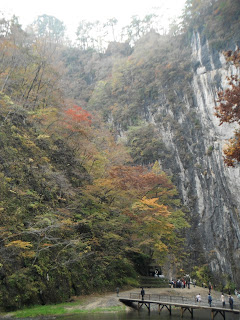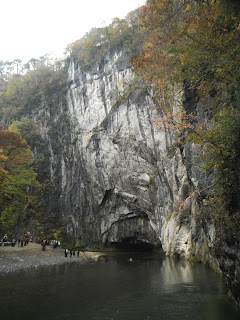My trip started from Akita City. I was able for the first time to ride Japan's famous Bullet Train (Shinkansen) from Akita City to Sendai. The journey takes approximately two and a half hours and covers a distance of approximately 152 miles. Upon arrival in Sendai, I headed off to meet the staff that had generously prepared the information for us all, Mr. Muroya and Miss Nemoto. They are absolutely wonderful people and we all had a great time together! After meeting at the station we walked to a nearby hotel where we stayed the first night. As we arrived Friday evening, after checking in to the hotel we headed out to dinner. The city of Sendai is quite famous for a dish by the name of ギユウタン this is pronounced "gyu-tan" and is flavorful, delicious cow tongue. Along with the cow tongue we ate a variety of different mouthwatering Japanese foods, and of course not to be forgotten drank just the right amount of 日本酒 Japanese sake. After an enjoyable night of Japanese tongue twisters, jokes, good food, sake, and splendid company we returned to the hotel for a bit of sleep before the start of the weekend's journey.
Saturday started with a journey to the recently named UNESCO World heritage site of Hiraizumi. The area is full of National historic sites including the Konjikido (Golden Hall), Pure Land Garden of Motsu-ji Temple, the Chuson-ji Temple along with many others. We first stopped at the information center on the way into the area to learn more about what we would be touring that day. After viewing some artifacts and reading about the history of the area we set out to the Chuson-ji Temple.
The area of Hiraizumi is especially famous due to the efforts of the first Oshu Fujiwara lord, Kiyohara. A man who's childhood was marked by the violence of war and the destruction of his family due to it. Kiyohara had a vision to create an area of Japan that was founded on the principles of the Buddha and to honor and make peace with those that had died in the Nine Year's War (1051-1061) and the Three Year's War (1083-1087). Therefore the area was developed with meticulous detail to the balance of the natural world. Hiraizumi geographically was an area that was rich with gold during that time, and as the area developed it became a center for trade. Artifacts from the area include shells and ivory that traveled on the Silk Road and made a final stop in Hiraizumi.
The Chuson-ji Temple has numerous halls and gardens surrounding it. One of the halls is the Konjikido or the Golden Hall. The all-gold hall was completed in 1124. It is covered in gold , silver dust, intricate metal work, mother-of-pearl, and was built with ornate craftsmanship. The central dais is where the body of Fujiwara no Kiyohira was laid to rest. Morohira was laid to rest in the left facing dais, Hidehera and Yasuhira were laid to rest in the right dais. The shimmering gold and two of the four heavenly kings, Jikokuten and Zochoten protect those laid to rest. The beauty and detail of the Golden Hall was unbelievable. As pictures were not allowed to be taken, please click the following link to learn more about this incredible treasure: The Golden Hall I also highly recommend you to visit the following and explore the site as it gives greater insight and context to the unique and special history of the area: More on Chusonji.
While a fire in 1337 destroyed many buildings, the Golden Hall and more than 3,000 National Treasures and Important Cultural Properties survived. Due to Kiyohara and his vision as well as his successors the area of Hiraizumi flourished and experienced a period of 100 years of peace. The history of the area is quite incredible and the amount of historic sites surrounding it is astounding. Hiraizumi is truly a unique harbor of Japanese history and culture.
Below are some pictures of the area surrounding Chuson-ji.
After touring the Chuson-ji Temple we headed to a nearby restaurant for lunch. After eating we headed to another temple in the Hiraizumi area known as the Takkoku no Iwaya Cave Temple. The temple was commissioned after the emperor Kanmu ordered the warrior-noble Sakanoue no Tamuramaro to lead an attack against the Emishi. After a successful campaign in 801, Tamuramaro had the temple built where the Emshi chief, who had terrorized the local population, had lived. Included on the grounds are the Bishamondo Hall, Benzaitendo Hall and the Sieko-ji Temple Main Hall.
Our last stop for the day was the Motsu-ji Temple. It was absolutely beautiful. In order to give some insight into the temple's founding, here is an excerpt from the information page about the temple:
"The temple history records that in the year 850 the great priest Ennin (Jikaku Daishi), the third head abbot of the Tendai sect, was traveling around northern Japan when he became lost in a thick fog in this area and was unable to proceed another single step.
When Ennin glanced at his feet, he noticed the hair of a white deer lying there beside them. Intrigued, the priest followed the trail of hair to find its owner, a white stag. Ennin approached the deer, but it vanished into the fog. In its place appeared a silver-haired old man who told the abbot, "This is a sacred place. If you build a temple here, the Buddhist law shall surely spread among the people."
Ennin sensed that this old man was an incarnation of the healing Buddha, Yakushi, and followed his advice. The priest built a hall which he named Kashoji, after the name of that historical period (850 was year 3 of Kasho). And that is the legend of Motsuji's founding."
If you would like a more in depth history of this sight please peruse the following link, Motsuji Temple Information.
While the area was once composed of nearly 40 different buildings and halls, many were destroyed due to fires over the years. However, the most famous feature of the location is the Pure Land garden. It is meant to represent the Pure Land of the Buddhist afterlife. It's construction and design were based on the teachings of the Sakuteiki, Japan's most ancient garden instruction script. It therefore includes components such as a peninsula, rocky outcrops, bridges, inclusion of the natural surroundings and scenery. It is an area that truly blends with the natural environment. A sense of peace and calmness comes over one's self upon entering and the balance between the natural world and the Pure Land of the Buddhist afterlife that the garden represents is profoundly moving.
The next day we woke up and headed to Geibi Gorge, a spot nearby Hiraizumi in Iwate Prefecture. Here we took a short boat trip up the Geibi Gorge. The river is paralleled by steep cliff walls on both sides, with foliage clinging to the outcrops and ledges of the rock. In the river numerous carp could be seen swimming by and along the river were numerous features, To'uhHoh (Cloud Spewing Rock), Bishamon Cave where there is a shrine to the god of treasure Bishamon, and Horse's-mane Rock, and the Great Rock of Geibi. The changing colors of the leaves and songs from our boat's guide gave a timeless feel to the journey.
Our final stop was in Toyoma Town where we had lunch and visited the historic school house of Toyoma Elementary School, the Police Museum, and walked around the town to view some of the Meiji Era buildings and architecture. The school itself was built in 1888 and modeled after western styled schools at that time.
After touring the town we boarded the bus and headed back to Sendai.
The food, culture, history, spirit, and, most of all, the people of the Tohoku region leave one with an unforgettable impression and make the journey memorable and heartwarming.
頑張ろう東北!
The food, culture, history, spirit, and, most of all, the people of the Tohoku region leave one with an unforgettable impression and make the journey memorable and heartwarming.
頑張ろう東北!

































